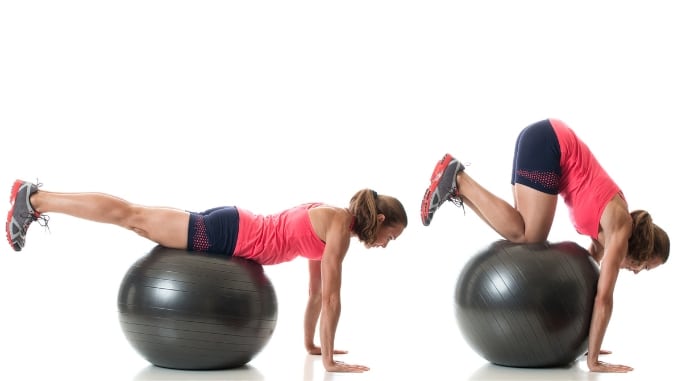Discover easy stability ball exercises designed for beginners that you can do at home. Our goal is to improve fitness and well-being straightforwardly. These uncomplicated exercises provide a simple entry point into your wellness journey, focusing on enhancing core strength, balance, and flexibility. They're not only easy to perform but also make staying active hassle-free. Let's keep it straightforward and enjoyable as we step toward a healthier you!
What is a Stability Ball?
A stability ball, alternatively known as an exercise ball or Swiss ball, is a great tool for fitness. It helps make your core (the muscles in your stomach and back) stronger, improves balance, and increases flexibility. Using a stability ball in your workouts is good because it makes exercises more interesting and effective by engaging different muscles.
Adding a stability ball to your exercise routine can help you stand and sit up straight, activate your core muscles, and improve overall body stability. This is important for staying fit and avoiding injuries.
Stability ball exercises are good for people at any fitness level, whether you're just starting or already advanced. They're especially good for beginners because they make working out more enjoyable. Whether exercising for your core, building strength or recovering from an injury, stability ball exercises are a fun way to improve your fitness, especially if you're starting your fitness journey.
Difference Between a Stability Ball and Exercise Ball
The terms “exercise ball” and “stability ball” are often used interchangeably, but there's a subtle difference. An exercise ball is a sizable inflatable ball used for various fitness activities. On the other hand, a stability ball emphasizes its role in enhancing stability and balance during exercises.
So, while all stability balls can be considered exercise balls, not all are designed with the primary focus on stability. The term “stability ball” highlights its application in promoting balance and engaging core muscles, distinguishing it as a specialized tool within the broader category of exercise balls.
Top Benefits of Stability Ball Exercises
 Core Strength Development – Stability ball exercises actively engage the core muscles, helping beginners build a solid foundation of core strength. This improves posture and provides a stable base for other daily activities and exercises.
Core Strength Development – Stability ball exercises actively engage the core muscles, helping beginners build a solid foundation of core strength. This improves posture and provides a stable base for other daily activities and exercises.- Enhanced Balance and Stability – Working out on a stability ball challenges the body's balance and stability. For beginners, this gradual introduction to balance exercises helps improve coordination and proprioception, reducing the risk of falls and injuries.
- Versatile Full-Body Workouts – Stability balls offer various exercises targeting different muscle groups, providing beginners with a versatile tool for full-body workouts. This variety keeps workouts interesting and ensures a comprehensive approach to overall fitness.
- Low-Impact Option for Joint Health – Many stability ball exercises are low-impact, making them gentle on joints, which is particularly beneficial for beginners or those with joint sensitivities. It allows individuals to build strength and endurance without excessive joint strain.
- Improved Posture Awareness – Bouncing on a stability ball helps you stand and sit up straight. This makes you more aware of your posture when exercising and all day. It's good for your back in the long run.
Adding stability ball exercises to your workout helps with overall fitness. It works on your core, balance, and flexibility and keeps your joints healthy. Plus, it makes sure you stand tall and sit straight.
8 Best Stability Ball Exercises at Home
For this exercise, use a stability ball or a Swiss ball for balance and core training.
1. Bouncing
Begin in an upright sitting position on the stability ball with your knees bent and feet flat on the floor. Maintain good alignment with your head, shoulders, and hips. Engage your core. Perform slow, controlled up-and-down movements on the stability call. Repeat the movement as needed.
To make this stability ball exercises for beginners more challenging, extend your arms overhead and bend your upper body to one side while keeping your balance on the stability ball. Repeat the movement on the opposite side.
 |
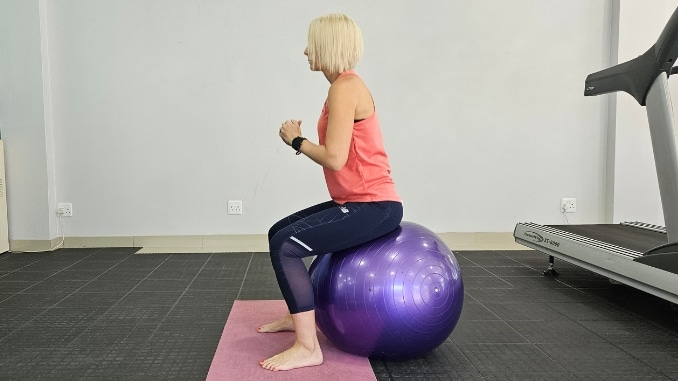 |
2. Seated Spinal Twist
Begin in an upright sitting position on the stability ball with your knees bent and feet flat on the floor, maintaining good alignment in your upper body and keeping your core engaged. Place one hand on your right knee. Contract your core and twist your upper body to one side, reaching back with your other hand for a light stretch. Hold this position for several deep belly breaths, in through your nose and out through your mouth. Relax and return to the starting position. Repeat the movement on the opposite side.
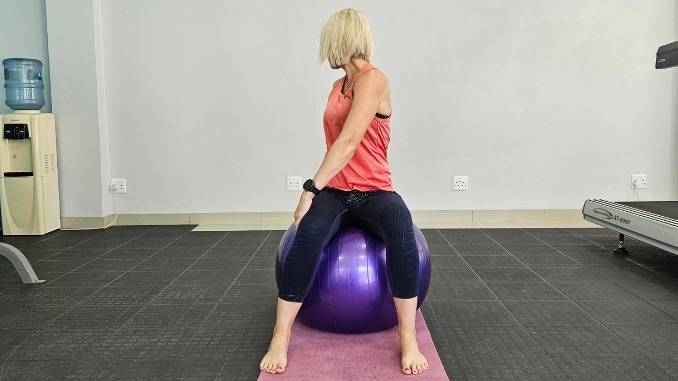
3. Hip Circles
Begin in an upright sitting position on the stability ball with your knees bent and feet flat on the floor. Maintain good alignment with your head, shoulders, and hips. Place both hands on your hips. Engage your core, then move your hips in a circular motion. Repeat the movement in the opposite direction.
To make this exercise easier, widen your stance.
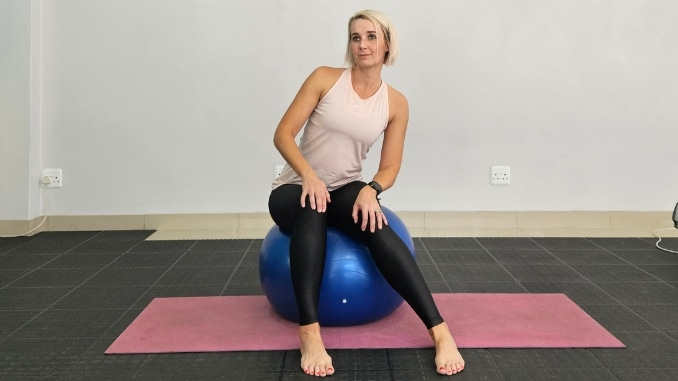 |
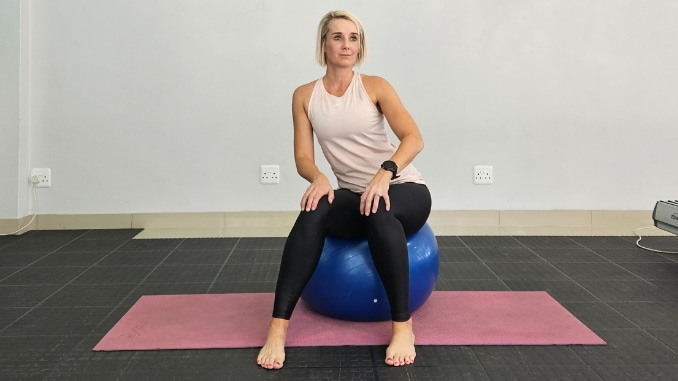 |
4. Leg Lifts
Begin in an upright sitting position on the stability ball with your knees bent and feet flat on the floor, maintaining proper alignment in your upper body. Place your hands on your hips. Tighten your core and lift your one leg up at chest height, holding this position for a couple of seconds. Return to the starting position and repeat the movement on the opposite leg. Complete 3 sets of 10 repetitions on each side.
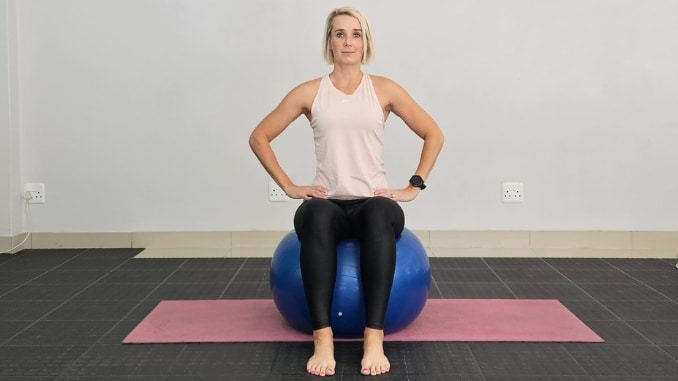 |
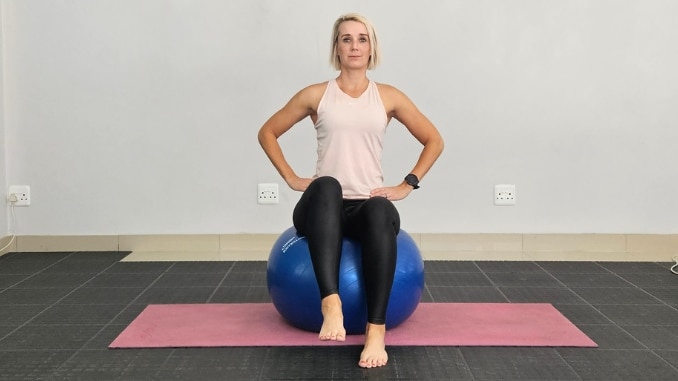 |
5. Crunches
Lie on your back on the stability ball with your knees bent and feet flat on the floor, maintaining good alignment with your head, shoulders, and hips. Bring your arms across your chest. Tighten your core and roll your upper body forward, keeping your gaze towards the ceiling as you maintain your balance. Relax and return to the starting position. Perform this movement for 3 sets of 10 repetitions.
To help you with your balance with this stability ball crunch, place your hands at your sides on the stability ball.
To make this stability ball exercises for beginners more challenging, twist your upper body from side to side at the end position.
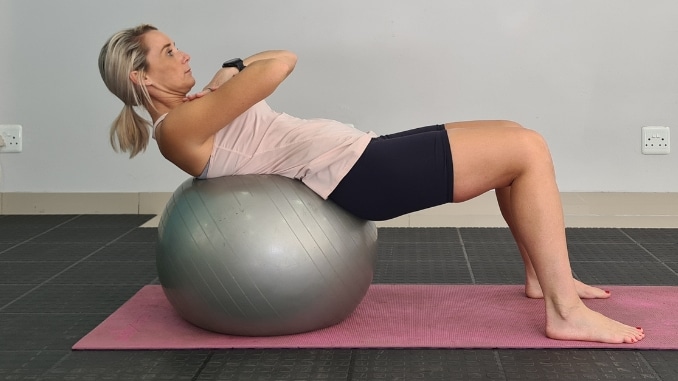 |
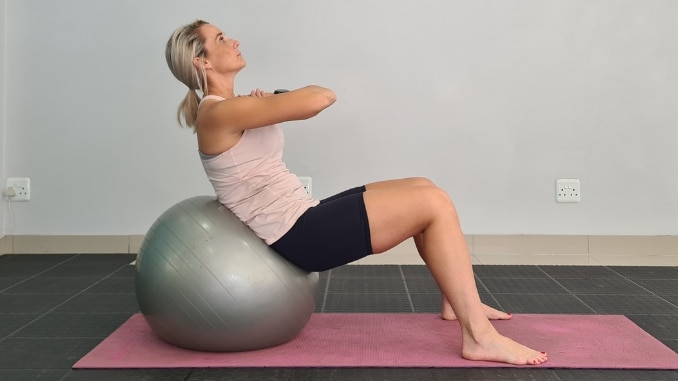 |
6. Leg Squeeze
Begin in an upright standing position with your feet hip-width apart, maintaining good alignment with your head, shoulders, hips, and legs. Place a stability ball between your legs and bring your hands to your hips. Engage your core and squeeze the ball between your knees, holding this position for a couple of seconds. Relax and repeat the movement. Complete for 10 repetitions.

7. Push-Ups
Move into a plank position with your arms straight and both legs extended on top of the stability ball, maintaining good alignment with your head, shoulders, hips, and legs. Contract your core muscles, then bend your arms to lower your upper body towards the floor, keeping your legs straight. Remember to keep your body in a straight line, to keep your balance. Straighten your arms to complete a push-up. Repeat the movement. Complete for 3 sets of 10 repetitions.
To make this exercise more challenging, position the stability ball closer to your feet.
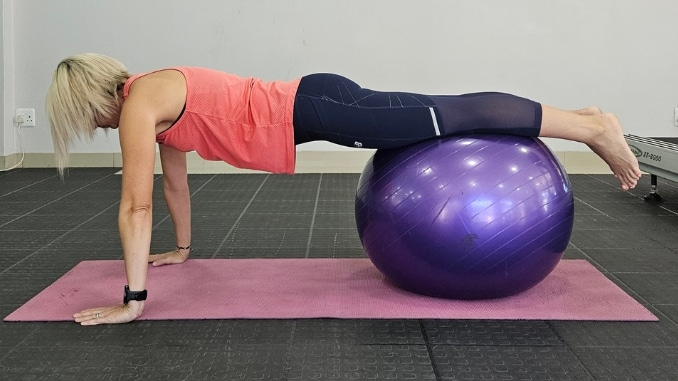 |
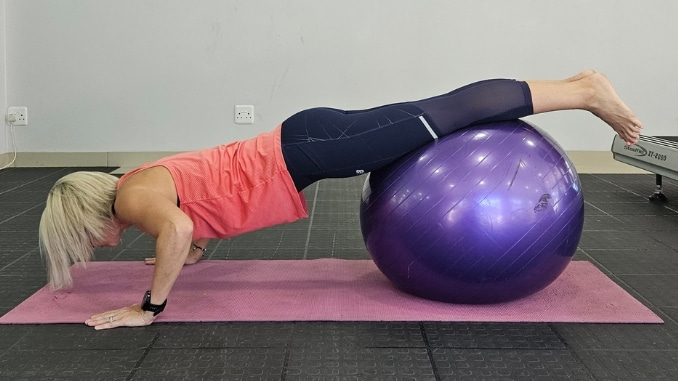 |
Note: Incorporate this stretch after every set to help you loosen up your body. Start in an upright kneeling position in front of the stability ball. Place both hands on the stability ball, tighten your core, and roll it forward until you stretch your arms and upper body parallel to the floor. Hold this position and return to the starting position.
8. Hip Thrust
Sit on the floor with your back against the stability ball, with your knees bent and feet flat on the floor. Place your hands on your belly or at your sides. Lift your seat and lean your shoulder blades and upper back against the ball. Engage your core and tighten your glutes as you push from your heels to lift your hips up toward the ceiling, maintaining proper alignment in your upper body. Relax and return to the starting position. Repeat the movement for 3 sets of 10 repetitions.
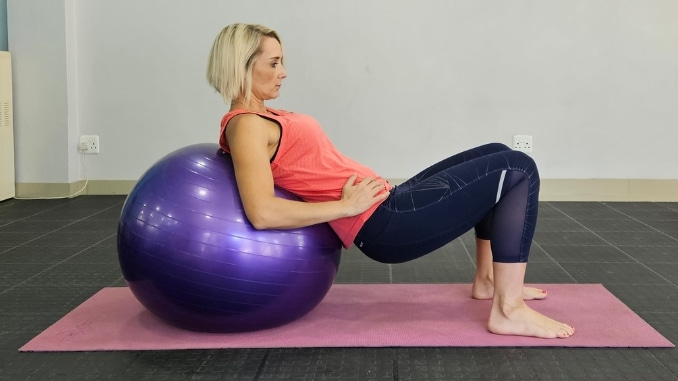 |
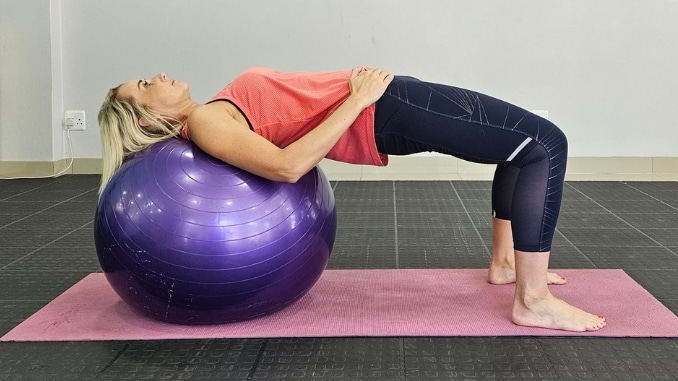 |
Safety Tips and Reminders for Stability Ball Exercises
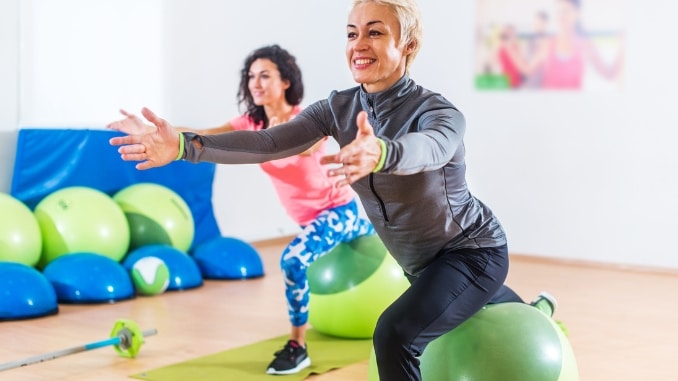
1. Proper Inflation and Size
Ensure that your stability ball is inflated according to the provided instructions. It's crucial to select the appropriate size—when seated on it, your knees should form a right angle, and your feet should firmly touch the ground. This ensures proper size stability ball usage, promoting stability and minimizing the likelihood of injury throughout your exercise routine.
2. Start Slow and Focus on Form
For beginners, it's crucial to commence with fundamental exercises and progressively advance. Concentrate on upholding correct form during each movement to optimize effectiveness and diminish the risk of strain. Whether engaging in stability ball pike or stability ball wall exercises, prioritize quality over quantity, emphasizing control and stability to avoid swift, uncontrolled motions.
3. Use a Stable Surface
Do stability ball exercises on a surface that won't make you slip, like a rug. Stay away from smooth tiles or wood floors—they're too slippery. And make sure there's nothing sharp or dangerous around where you're exercising.
Remember these tips:
-
- Keep the ball the right size and pumped up.
- Start easy.
- Focus on your moves.
- Use a solid surface.
That way, your stability ball workout will be better and safer, so you can enjoy it more.
Conclusion: Embracing the Importance of Exercises for Beginners
To sum it up, stability ball workouts have lots of good points. Incorporating a stability ball is comforting and handy. It also does many things—it boosts core strength, balance, flexibility, and how well you control your whole body. Plus, it makes workouts more fun and interesting by adding a bit of a challenge. It's easy on your body and works for people at different fitness levels.
If you're starting, get the right way to use it. That way, you get all the good stuff without risking getting hurt. Stability balls are a smart, affordable, and space-saving way to level your workouts. If you're new to exercising, it's a great idea to give it a go and spice up your fitness journey. Check out Strong & Stable Stability Ball Workout now!

